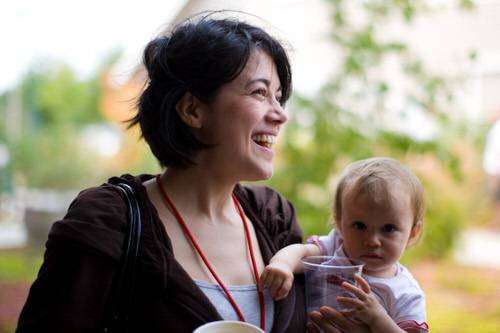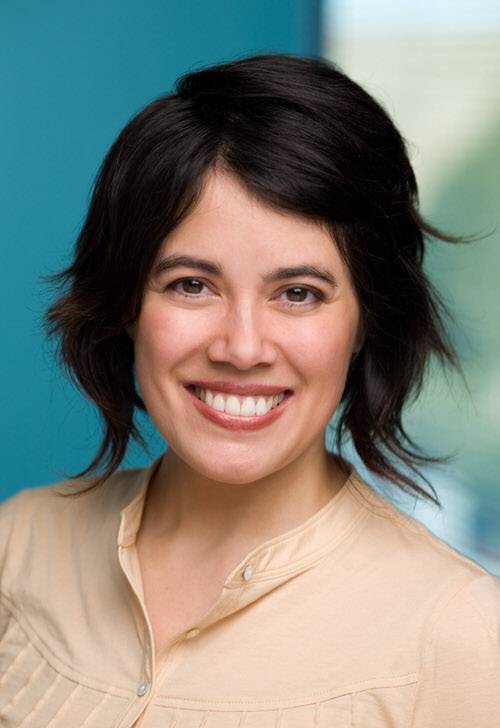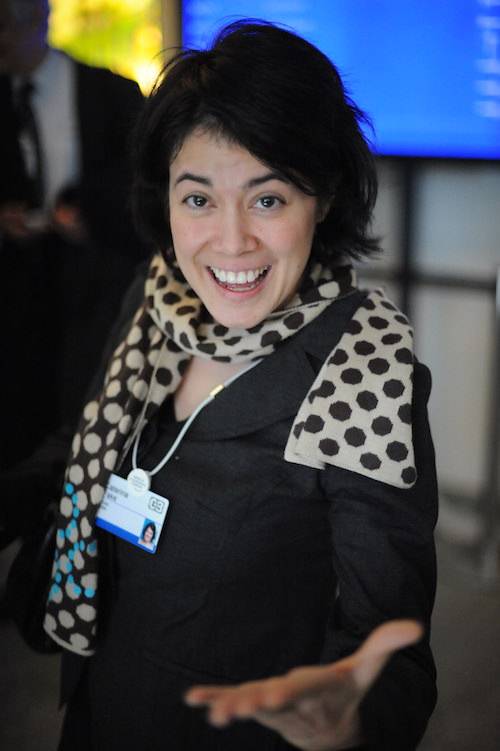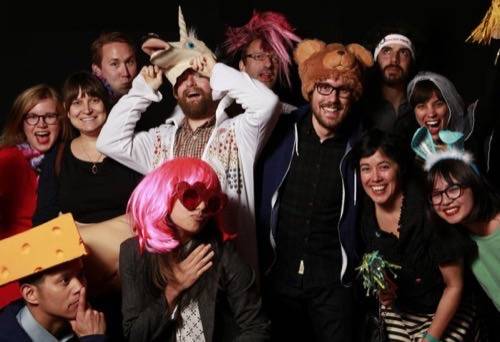ReadWriteBuilders is a series of interviews with developers, designers and other architects of the programmable future.
Entrepreneur, designer and artist Caterina Fake was one of the early pioneers of the Web. She was one of the first online graphic designers and a blogger before people thought it was normal to post personal information online.
Fake has spent her career creating services that change the way we use the Web—photo-sharing service Flickr, acquired by Yahoo; decision-making website Hunch, acquired by eBay; and now Findery, an app for discovering art, history and notable destinations all around you.
Findery, available on the Web, iOS and Android, is for storytelling. People can add “notes” about certain locations—for instance, detailing some history of a particular building. That lets others who are traveling or just exploring their surroundings learn things that might not be in a guidebook.
“Notemaps,” or a string of notes on a similar topic, are also a way for users to share their journeys through photos, words, and location information. One notemap called “In Love” is a collection of stories about romantic journeys contributed by Findery users.
Fake said that all her businesses have something in common—they combine technology with art and community, and put the people first. And while there are now screens almost everywhere we look, Fake doesn’t want people to become lost in their technology, rather use the tools and devices to amplify the present world around them.
Now with notes in 196 countries and a recently launched Android app, Findery is hoping to become a new way for people to discover the community around them through photos, community and shared stories.
Making Things Beautiful And Useful

RW: Can you talk more about how you’ve been developing for the intersection of arts and technology? What inspires you to make that connection?
CF: I’m a liberal arts major. I studied art and I studied English. I almost went to grad school to study Renaissance literature. I was trained as an artist. I was trained as an oil painter. I’ve always had an affinity for it.
See also: The Art Of Technology And Vice Versa: Polyvore’s Jess Lee
I came out here as a recent college graduate. I had always had an interest in computers, and I’ve always been online—that was before 1994, before there was much activity online. I had been working as a painter in NYC as a fine artist, then I moved out here [to San Francisco] and I felt myself to be unemployable. But I had this skill in aesthetics that I could translate into Web design. I got into it really by accident.
I carried forward these tendencies I already have. I carried it into this new realm of technology and the Internet, and it became a career. I was a very early blogger also. I started in 1998, really early on, and that was a thriving community.
I always felt that was a very important part of the Internet, that people tell their stories, that there be a multiplicity of voices online and be an avenue for people to connect themselves. That’s really been something that we’ve focused on throughout all of my career. It’s been very effective for companies who build these types of communities that are arts related, and about storytelling.
Sketching Out An Online Vision
RW: Flickr was your first company, right? Can you talk about how you went from being a painter and designer to being a technical entrepreneur?
CF: In many ways it was being in the right place at the right time.
I started doing CD-ROM educational title design. This was back in the days of CD-ROMs, before the Web really took off. I got really lucky because I was living in New York and had gotten a job as a temp in the IT department at Columbia University in early 1990s. And somebody showed me a Mosaic browser, right when it came out.
I had been online already and been very active in the bulletin-board days of the Internet. I was very attracted to and interested in all of this blooming technology. So I was in a good place at a good time. There was such a small community—there were so few people working in the industry at the time. It kind of felt like there were 300 people working in Web design at the time. I had spent time in online communities like The Well, and it just kind of evolved naturally from that.
I did Web design, I taught myself HTML and to write basic code, I published zines, I published a blog, and put up my own website. I was on Geocities. There were a lot of really wonderful, early online communities like that.
It was in ’95 that I joined Organic, one of the very first Web development shops. I took it from there. It wasn’t an obvious path. It was one of those things that if you just keep your mind open, you can look for opportunities around you.
But I don’t think my parents were very optimistic about my post-college opportunities.
RW: Did you set out to build an image sharing platform that just happened to become one of the most popular photo-sharing sites on the Web?

CF: We were hoping it would be successful, but we didn’t really have any idea how successful it would be. There’s a lot of work that went into it, a lot of luck that went into it, a lot of things happening with just the general forces of the Internet at the time. This was 10 years ago now, and the timing was just right.
It was kind of like, blogging was seen as this weird fringe behavior. “Why would you want to put a picture of yourself online? That’s so weird.” That was changing. Friendster had a lot to do with it. In the early days, getting people getting over that hump of having a profile of yourself online. It was kind of a new idea.
The year that we launched Flickr [in 2004]—it was the first year that the majority of smartphones were equipped with a digital camera. It was also the year that more than 50% percent of all households had broadband Internet, so you could actually download a photo. So that was a huge thing.
See also: LittleBits’Ayah Bdeir: Making Hardware As AHackable As Code
A lot of things happened around that time. Another thing is that the cost of storage had been falling year after year. It used to be very expensive to operate a server, and that was dropping. It was a perfect storm of different factors … that made it the perfect time for Flickr.
Looking at the current landscape, there are screens in everyone’s cars, in dashboards, on planes, the apple watch, google Glass, you can kind of see what’s going on is that people are no longer connected to, we still have all our phones, but we’re going to be liberated from our phones. And you know the sense of traveling with you is where things are going next.
RW: Do you think that perfect storm of factors helped with the virality of Flickr? Do you think it’s harder to go viral on the Internet now, 10 years later?
CF: In some ways, going viral is no longer the same kind of challenge it was. In some ways it’s harder, and in some ways it’s easier.
There are all these different devices you have, and all these different contacts. The challenge has always been tapping your social network, those challenges have been made easier.
But then, there are many social networks, there are a lot more developments going on. There’s more noise—in that aspect, it’s harder.
Defining Findery
RW: Can you talk a little bit about why Findery is so unique and how you’re hoping people use the app?
CF: We’ve really tried to do a couple things: We thought that location-based services were really centered around ratings, reviews and recommendations. So really about “Where should I have dinner?” or “Show me what to do here.”
We wanted to get away from that sense of place.
See also: Foursquare CEO Dennis Crowley: How We’ll Tell You Where To Eat And What To Order
The thing we really want to try to do is bring out the meaning and history of a place. All other aspects of the place that don’t have to do with business transactions. Bringing a travel mindset local.
You know that famous slide with Steve Jobs, at the end of one of this last presentations, he was standing in front of a sign that said “Technology and Liberal Arts.” That’s kind of where we feel we are. Here’s the history of a place, here’s the sociology of a place, here’s what people are saying about this place. Here are people’s contributions.
That’s what we feel we’re really good at. If you look at the companies over the years that I have been either a founder or on a board or an investor in, like Flickr, Etsy, or Kickstarter, the great common thread in them is about creativity and telling stories.
Those are some of our particular strengths and what make us different from Yelp or other things.
What’s really interesting about technology in general, when we started this company, it was very clear that things were going to be on mobile, and that mobile was what we should be developing for. Now wearables are becoming a reality. Screens are now going to be in the dashboard of your car. Screens not even confined to your handheld device anymore.
We have this space that is really expanding to include all of these screens in places that are moving, in the back of a cab, or in front of you on the airplane. As you’re flying over Greenland, wouldn’t it be interesting to see, what’s this place like now? We are designing for all of these products that are just rolling out. So I’m super excited for us. We’re in a good position to be on all of these mobile screens.
Where Technology Meets Liberal Arts

RW: What were some of the most important lessons that you’ve learned after founding multiple startups? How are you applying them to Findery?
Things change constantly. I don’t think that any entrepreneur can keep doing the same thing over and over. You have to know what experience to carry forward, and what experience to leave behind.
I think one of the big challenges is actually cultivating beginners minds and making sure you’re still open to the world and continue to see new things. You can actually get jaded. You can stop seeing things that are new. You can start fearing failure. Those are the things an entrepreneur needs—an open mind and the ability to see the world with new eyes.
That’s the challenge of being an entrepreneur.
RW: How do you think Yahoo is running Flickr? Did you ever anticipate its current form?
CF: It’s funny. It’s like when your company has been acquired by another company, you can care for it for a certain amount of time, then you have to let go. You can compare it to NASA and the space shuttle. You can care for it as much as you can, then the rocket ship goes into outer space, and there it is.
I know exactly what I would do with Flickr right now, but I’m not running it anymore. So from my perspective, I’ve launched a rocket. You just have to hope that all of the stuff you put into it before it launched, works.
The thing that’s always been the strongest thing about Flickr is the community. So long as the people continue to be supported, that’s the important part.
RW: My editor Owen Thomas pointed to me about a blog post you wrote, the concept of Biz Dev 2.0. Is that something that’s translated over the years? Companies opening up their API and allowing other companies to build off it?
CF: Earlier in the conversation I was mentioning that being present on all these different platforms, being on dashboards or wearables, none of that would really be possible without an API.
That still holds true now more than ever. When we were developing products when I wrote that back in 2006, there were even fewer places that your data could appear. They’ve just multiplied. When we started Flickr, it was a pretty simple process.
Since we’ve developed Findery, we started on the Web and mobile Web, and we had an iOS version, and now an Android version. It’s just multiplied. We were pretty much developing for a single platform 10 years ago, and you can’t do that anymore.
You can’t just be constrained to one. I think that that’s even more true than ever.
Being Present In The World
RW: So what’s next for Findery? What will success look like?

CF: One of the things that was really great is that we have an intern that said Findery changed her experience of the world. When she was walking, instead of looking down at her phone, she was being present to the world. Technology can remove us from the people and places around us—you can be going into some Internet world in the sky instead of being present where you’re standing.
If we’re successful, it seems like an irony for a technology company, but it would be to make people present in places where they are and the places around them
The people on the bus, or people walking down the street, the lines in the pavement and the weather, all the stuff that’s around you. Not be so involved in the virtual world. Which sounds very old-world now. That’s a term circa 1999.
Lead image by nrkbeta; others by Joi Ito, Robert Scoble and Caterina Fake; Findery team photo courtesy of Findery










